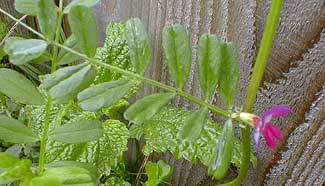
Wild Vetch or Pea; aka,
American Purple Vetch
"A weed is no more than a flower in disguise."
-James Lowell
(1819-1891)
(1819-1891)
Vicia americana americana is an inescapable weed, a little pea that crops up around the edges of the property in dry neglected areas. It also likes moist ground but does not compete well with taller plants so we really only see it in places we aren't gardening or tending, where spring rainfall is all the watering it gets. Sometimes its teency purple flowers are extremely numerous & beautiful in early & mid Spring, so I find it easy not to dislike its delicate presence merely for being a weed.
In Maryland it is included among rare & protected wildflowers, but in some regions of the west & southwest, it is a nuisance invading agricultural croplands. It is not a nuisance in rangelands because cattle browse it & it tends to vanish from areas where cattle, sheep, goats, elk, or deer graze regularly. It feeds small mammals & game birds, too. It is useful for honeybees & tinier pollinators, & is overall much more beneficial than ever it is a nuisance.
As do wild clovers, American vetch helps to fix nitrogen in poor soils, so deserves more tolerance when it spreads through ungardened areas. It has been intentionally introduced into depleted western rangelands within its natural range, so as to help revitalize the soil.
North American First Peoples included wild vetch in their diet. Young tender shoots are perfectly edible. Seed pods are edible either flat & immature, or with the half-dozen eency peas fully formed within the pod. It is not a fashionably wild-gathered food today because of the hard work to gather enough of anything so small. Also, some species of vetch are very toxic, & none should be eaten unless knowing with complete certainty the type.
As a medicinal plant it has been used for skin itches & insect bites, either by rubbing crushed leaves on the itch or injury, or by bathing in water with plenty of crushed leaves. Its most significant chemical component, levodopa, has been synthesized for pharmacalogical purposes, providing some degree of assistance in controlling symptoms of Parkinson's disease including trembling, & controlling seborrhea (scaly or oily skin), & possibly shingles. Levodopa has to be used always with a physician's careful supervision. As a dried herb per se, wild vetch has only moderate value as topical treatment for itch.
It creeps or climbs about in meadowy locations from alpine elevations to sea level throughout much of North America, from Alaska to California, from Ontario to Virginia, from Kentucky to Arizona. It is lacking only in the deep south. The subspecies V. americana minor is called Mat Vetch & though not native of the Northwest, it is found through much of midwest & southwest overlapping its range with that of V. americana americana, though in Texas only Mat Vetch is found.
Though locally in bloom primarily in April & May, its flowers can be spotted as early as March, as late as August, though scarcer from June on. It's a perennial & obviously self-seeds with complete fascility. It has a moderately deep taproot reaching to a foot depth commonly, over three feet occasionally, so wouldn't transplant easily, supposing there was ever reason to do so.